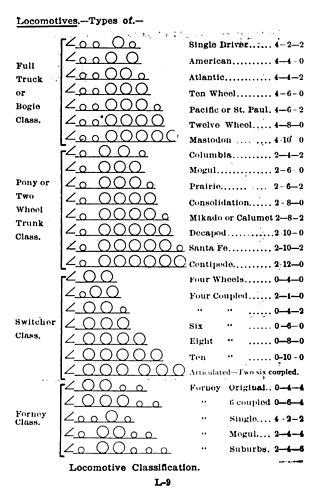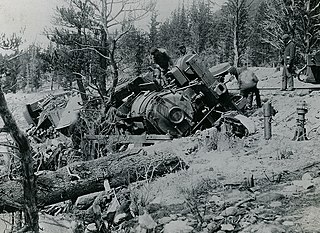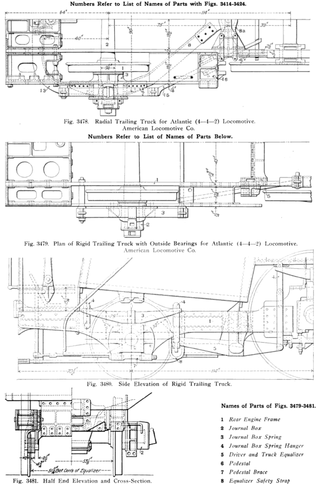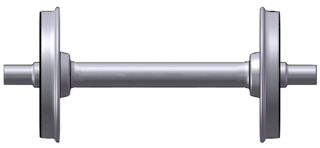
A bogie or railroad truck holds the wheel sets of a rail vehicle.

A bogie or railroad truck holds the wheel sets of a rail vehicle.
An axlebox, also known as a journal box in North America, is the mechanical subassembly on each end of the axles under a railway wagon, coach or locomotive; it contains bearings and thus transfers the wagon, coach or locomotive weight to the wheels and rails; the bearing design is typically oil-bathed plain bearings on older rolling stock, or roller bearings on newer rolling stock. [1]
Plain bearings are now illegal for interchange service in North America. [2] [3] [4] As early as 1908 axle boxes contained a set of long cylindrical rollers allowing the axle to rotate. [5] [6] It was also used on steam locomotives such as the Victorian Railways A2 class, the LMS Garratt, the LSWR 415 class, and the GCR Class 1. [5] [ dubious ]
A large steel pin—or rod—which passes through the center plates on the body bolster and truck bolster. [7] The truck turns about the pin, and stress is taken by the center plates. [7]
One of a pair of plates which fit one into the other and support the car body on the trucks allowing them to turn freely under the car. [7] The one on the truck may also be called center bowl. [8]
Each truck has a bolster—a transverse floating beam—between the side frames. [9] It is the central part of every truck on which the underframe of the railcar or railroad car is pivoted through the center pivot pin. [7] [9]
There is one side bearing located on each side of the centerplate on the truck bolster. In case of a shared bogie on an articulated car, there are two on each side.
The brake rigging includes the brake lever, the brake hanger, the brake pin, the brake beam and the brake shoes.
| | This section needs expansion. You can help by adding to it. (February 2022) |

A bogie is a chassis or framework that carries a wheelset, attached to a vehicle—a modular subassembly of wheels and axles. Bogies take various forms in various modes of transport. A bogie may remain normally attached or be quickly detachable. It may include a suspension component within it, or be solid and in turn be suspended ; it may be mounted on a swivel, as traditionally on a railway carriage or locomotive, additionally jointed and sprung, or held in place by other means.

The Whyte notation is a classification method for steam locomotives, and some internal combustion locomotives and electric locomotives, by wheel arrangement. It was devised by Frederick Methvan Whyte, and came into use in the early twentieth century following a December 1900 editorial in American Engineer and Railroad Journal.

A 2-8-8-4 steam locomotive, under the Whyte notation, has two leading wheels, two sets of eight driving wheels, and a four-wheel trailing truck. The type was generally named the Yellowstone, a name given it by the first owner, the Northern Pacific Railway, whose lines ran near Yellowstone National Park. Seventy-two Yellowstone-type locomotives were built for four U.S. railroads.
Rail transport terms are a form of technical terminology applied to railways. Although many terms are uniform across different nations and companies, they are by no means universal, with differences often originating from parallel development of rail transport systems in different parts of the world, and in the national origins of the engineers and managers who built the inaugural rail infrastructure. An example is the term railroad, used in North America, and railway, generally used in English-speaking countries outside North America and by the International Union of Railways. In English-speaking countries outside the United Kingdom, a mixture of US and UK terms may exist.

Main components found on a typical steam locomotive include:

In rail transport, a derailment is a type of train wreck that occurs when a rail vehicle such as a train comes off its rails. Although many derailments are minor, all result in temporary disruption of the proper operation of the railway system and they are a potentially serious hazard.
The AAR wheel arrangement system is a method of classifying locomotive wheel arrangements that was developed by the Association of American Railroads. Essentially a simplification of the European UIC classification, it is widely used in North America to describe diesel and electric locomotives. It is not used for steam locomotives,, which use the Whyte notation instead.

On a steam locomotive, a trailing wheel or trailing axle is generally an unpowered wheel or axle (wheelset) located behind the driving wheels. The axle of the trailing wheels is usually located in a trailing truck. On some large locomotives, a booster engine was mounted on the trailing truck to provide extra tractive effort when starting a heavy train and at low speeds on gradients.

A defect detector is a device used on railroads to detect axle and signal problems in passing trains. The detectors are normally integrated into the tracks and often include sensors to detect several different kinds of problems that could occur. Defect detectors were one of the inventions which enabled American railroads to eliminate the caboose at the rear of the train, as well as various station agents placed along active routes to detect unsafe conditions. The use of defect detectors has since spread overseas to other railroad systems.

A hot box is the term used when an axle bearing overheats on a piece of railway rolling stock. The term is derived from the journal-bearing trucks used before the mid-20th century. The axle bearings were housed in a box that used oil-soaked rags or cotton to reduce the friction of the axle against the truck frame. When the oil leaked or dried out, the bearings overheated, often starting a fire that could destroy the entire railroad car if not detected early enough.
The Timken Roller Bearing Company was one of the first to introduce roller bearings for railroad cars. Railroad cars owned and operated by the Atchison, Topeka and Santa Fe Railway were some of the first to use roller bearings rather than "oil waste journal" boxes. Henry Timken, a German immigrant, invented an improved bearing and founded the company in 1899. It was later renamed The Timken Company.

A variable gauge system allows railway vehicles in a train to travel across a break of gauge between two railway networks with different track gauges. For through operation, a train must be equipped with special bogies holding variable gauge wheelsets which contain a variable gauge axle (VGA).

Jacobs bogies are a type of rail vehicle bogie commonly found on articulated railcars and tramway vehicles.

ER2 electric trainset is a DC electric multiple unit which was in production by the Railroad Machinery Plants of Riga from June 1962 to mid-1984. It was essentially an improvement of the ER1 design, featuring footboards for low platforms, and aprons for high platforms, as well as improved electrical equipment and minor changes to the bodywork. Since the mid-1960s, the ER2 has been the most widely used type of suburban train in the Soviet Union and its successor states.

A wheelset is a pair of railroad vehicle wheels mounted rigidly on an axle allowing both wheels to rotate together. Wheelsets are often mounted in a bogie – a pivoted frame assembly holding at least two wheelsets – at each end of the vehicle. Most modern freight cars and passenger cars have bogies each with two wheelsets, but three wheelsets are used in bogies of freight cars that carry heavy loads, and three-wheelset bogies are under some passenger cars. Four-wheeled goods wagons that were once near-universal in Europe and Great Britain and their colonies have only two wheelsets; in recent decades such vehicles have become less common as trainloads have become heavier.

Bogie exchange is a system for operating railway wagons on two or more gauges to overcome difference in the track gauge. To perform a bogie exchange, a car is converted from one gauge to another by removing the bogies or trucks, and installing a new bogie with differently spaced wheels. It is generally limited to wagons and carriages, though the bogies on diesel locomotives can be exchanged if enough time is available.

The South African Railways Class 21 2-10-4 of 1937 was a class of steam locomotives used in South Africa.

A train wheel or rail wheel is a type of wheel specially designed for use on railway tracks. The wheel acts as a rolling component, typically press fitted onto an axle and mounted directly on a railway carriage or locomotive, or indirectly on a bogie, also called a truck. The powered wheels under the locomotive are called driving wheels. Wheels are initially cast or forged and then heat-treated to have a specific hardness. New wheels are machined using a lathe to a standardized shape, called a profile, before being installed onto an axle. All wheel profiles are regularly checked to ensure proper interaction between the wheel and the rail. Incorrectly profiled wheels and worn wheels can increase rolling resistance, reduce energy efficiency and may even cause a derailment. The International Union of Railways has defined a standard wheel diameter of 920 mm (36 in), although smaller sizes are used in some rapid transit railway systems and on ro-ro carriages.
An equalising beam, equalising lever or equalising bar links the suspension of two or more adjacent axles of a vehicle, especially a railway locomotive.
A cannon bearing or cannon box bearing is an arrangement of bearings on a shaft, usually an axle, where two bearings are mounted in an enclosed tube.